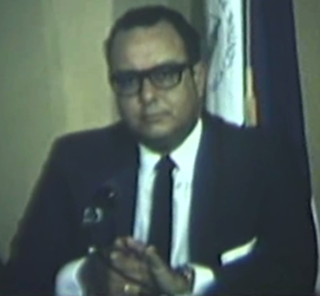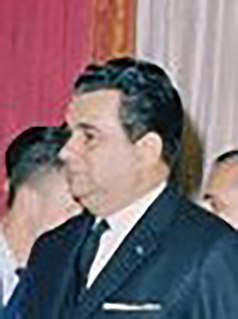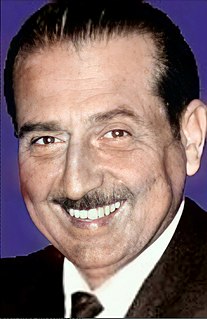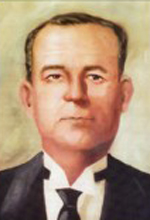Related Research Articles
Nicaragua is a nation in Central America. It is located about midway between Mexico and Colombia, bordered by Honduras to the north and Costa Rica to the south. Nicaragua ranges from the Caribbean Sea on the nation's east coast, and the Pacific Ocean bordering the west. Nicaragua also possesses a series of islands and cays located in the Caribbean Sea.

The Sandinista National Liberation Front is a socialist political party in Nicaragua. Its members are called Sandinistas[sandiˈnistas] in both English and Spanish. The party is named after Augusto César Sandino, who led the Nicaraguan resistance against the United States occupation of Nicaragua in the 1930s.

Anastasio "Tachito" Somoza Debayle was a Nicaraguan dictator and officially the President of Nicaragua from 1 May 1967 to 1 May 1972 and from 1 December 1974 to 17 July 1979. As head of the National Guard, he was de facto ruler of the country between 1972 and 1974, even during the period when he was not the de jure ruler.

The Somoza family was an autocratic family dictatorship in Nicaragua that lasted forty-three years, from 1936 to 1979. They were closely allied with the United States.

Anastasio "Tacho" Somoza García was officially the 21st President of Nicaragua from 1 January 1937 to 1 May 1947 and from 21 May 1950 until his assassination on 29 September 1956, but he ruled effectively as dictator from 1937 until his assassination. Anastasio Somoza started the Somoza family, a family dictatorship that maintained absolute control over Nicaragua for 42 years.

The Nicaraguan Revolution encompassed the rising opposition to the Somoza dictatorship in the 1960s and 1970s, the campaign led by the Sandinista National Liberation Front (FSLN) to oust the dictatorship in 1978–79, the subsequent efforts of the FSLN to govern Nicaragua from 1979 to 1990, and the Contra War, which was waged between the FSLN-led government of Nicaragua and the United States–backed Contras from 1981 to 1990. The revolution marked a significant period in the history of Nicaragua and revealed the country as one of the major proxy war battlegrounds of the Cold War, attracting much international attention.
Pedro Joaquín Chamorro Cardenal was a Nicaraguan journalist and publisher. He was the editor of La Prensa, the only significant opposition newspaper to the long rule of the Somoza family. He is a 1977 laureate of the Maria Moors Cabot Prize of Columbia University in New York. He married Violeta Barrios de Chamorro, who later went on to become President of Nicaragua (1990-1996). In 1978, he was shot to death, one of the precipitating events of the overthrow of the Somoza regime the following year.

Luis Anastasio Somoza Debayle was the 26th President of Nicaragua from 21 September 1956 to 1 May 1963, but he was effectively dictator of the country from 1956 until his death in 1967.

Francisco Urcuyo Maliaños was a Nicaraguan politician, who served as Vice President of Anastasio Somoza Debayle from May 1967 to May 1972. He was born in Rivas.
Roberto Sacasa Sarria was the President of Nicaragua from 5 August 1889 to 1 January 1891 and again from 1 March 1891 to 11 July 1893.

Carlos Alberto Brenes Jarquín was the President of Nicaragua from 9 June 1936 to 1 January 1937. He was a member of the Nationalist Liberal Party. Brenes was the president of the lower chamber of National Congress of Nicaragua in 1933. He was installed as president by national guard commander Anastasio Somoza Garcia following a military coup on 9 June 1936, and remained in office until Somoza became president on 1 January 1937.
Leonardo Argüello Barreto was a Nicaraguan politician who, after several attempts, became the President of Nicaragua in 1947. He served from 1 May to 27 May 1947. His older brother was the noted poet Santiago Arguello Barreto.
Benjamín Lacayo Sacasa was the President of Nicaragua from 27 May to 15 August 1947.
Víctor Manuel Román y Reyes was the President of Nicaragua from 15 August 1947 to his death on 6 May 1950. His Vice President was Mariano Argüello Vargas, a former Foreign Minister and President of the Senate of National Congress of Nicaragua.
Lorenzo Guerrero Gutiérrez was a Nicaraguan politician and a close associate of Somoza family. Guerrero was the president of the upper chamber of National Congress of Nicaragua 1949–1950, 1953–1954, 1956-1957 and 1962. Guerrero served as one of the Vice Presidents in the administration of René Schick from May 1963 to August 1966 and became President of Nicaragua on 4 August 1966 following the death of Schick. Guerrero served the remainder of Schick's term and handed over the presidency to Anastasio Somoza Debayle on 1 May 1967, who in turn appointed Guerrero as his Foreign Minister. He was a relative of his predecessor René Schick.

Caballero Rivero Woodlawn North Park Cemetery and Mausoleum is one of the oldest cemeteries in Miami, Florida. Woodlawn Park Cemetery-North was established in 1913 by three pioneers in Miami’s early history – Thomas O. Wilson, William N. Urmey and Clifton D. Benson. The Woodlawn group of cemeteries grew throughout the years, and funeral homes were added as well. The founders imported rare tropical trees and shrubs to adorn the cemetery, including the first schefflera and mahogany trees brought to the United States.

General elections were held in Nicaragua on 2 February 1947 to elect a president and National Congress.

Constitutional Assembly elections were held in Nicaragua on 6 November 1938.
The elections held on 6 November 1938 were even more of a sham than those that named Anastasio Somoza García president in 1936. The Conservatives decided to abstain again, while the ballot boxes and ballots were distributed throughout the country by the quartermaster general of the Guardia Nacional. The final results were made available within twenty-four hours. In 1938 the Genuino Conservatives decided to field candidates for the Constituent Assembly although the Conservative party’s leadership vehemently opposed the plan.

General elections were held in Nicaragua on 6 November 1932 to elect a President, half of the seats in the Chamber of Deputies and one-third of the seats in the Senate of the National Congress.

Presidential elections were held in Nicaragua on 9 June 1936.
References
- ↑ , worldstatesmen.com, accessed 2010-1-15.
- ↑ "APRUÉBESE CONVENIO DE LA III CONFERENCIA DE MINISTROS DE AGRICULTURA DE CENTRO". legislacion.asamblea.gob.ni.
- ↑ report on Somoza's funeral